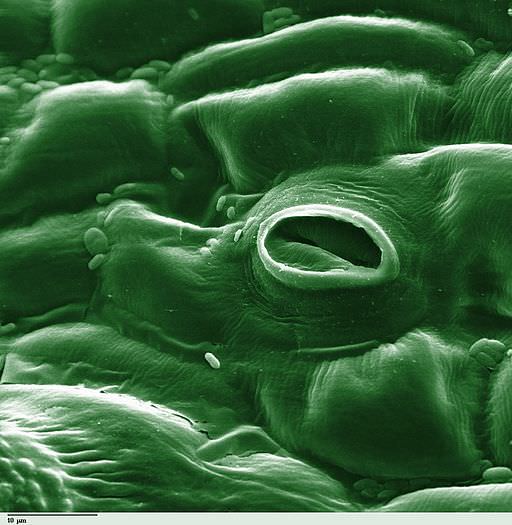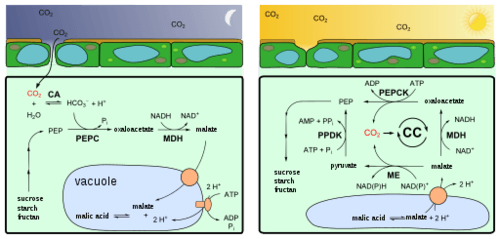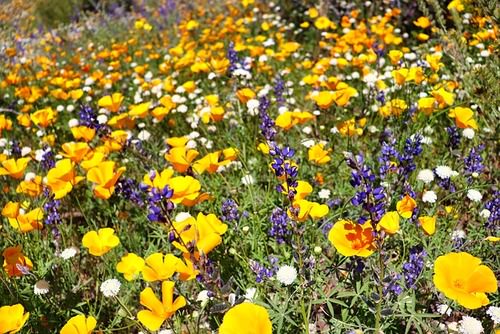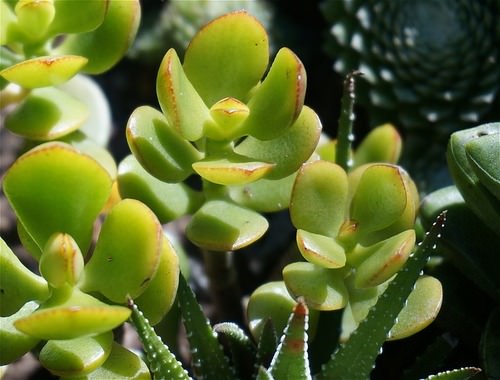13.54 氧气 - 高级
Section outline
-
Xerophytes: Competing for Water
::Xerophites:水的竞争In contrast to , xerophytes live at the dry extreme of the moisture continuum. Deserts, but also aerial rainforest niches and frozen tundra, create conditions in which evapotranspiration exceeds precipitation for all or part of the growing season . Xerophytes specialize in , allowing them to thrive in these conditions.
::相对地,xerophytes生活在潮湿连续体中的干燥极端。 沙漠,但也包括空中雨林空间和冰冻的苔原,创造了一种条件,使蒸发的蒸发量超过整个或部分生长季节的降水量。 Xerophytes专门从事,允许它们在这些条件下蓬勃发展。Much as you budget your money, xerophytes budget water through three basic strategies:
::使用三条基本战略来预算水:-
Increase or maximize income
: Such
adaptations
increase water intake.
::增加或最大限度地增加收入:这种调整增加了水的摄取量。 -
Limit and conserve outflow
: These adaptations
the loss of water.
::限制和节约流出:这些调整是水的流失。 -
Build up reserves
: Specialized storage structures take advantage of water when it is available.
::建立储备:专用储存结构在水可用时利用水。
Adaptations which Increase Water Intake
::增加水吸收量的适应Adaptations which increase water intake include deep , wide spreading shallow roots, and the ability to absorb surface moisture. Mesquite trees and shrubs, for example, have taproots , which literally tap the water table; the record depth is 58 meters (190 feet)! Many cacti have a different strategy: shallow roots extend widely to gather as much moisture as possible from rare rainfalls. A young Saguaro only 12 cm (4 1/2 inches) high may have roots reaching out 2 meters (7 feet) but penetrating no more than 10 cm (4 inches) deep. Saguaro roots grow quickly immediately following a rainfall, and by maintaining a high salt concentration within the roots, they absorb moisture rapidly via . Some cacti can absorb moisture from fog or dew, directly through the epidermis and/or thorns. for water among xerophytes is fierce, so these adaptations may determine plant distributions or, at extremes, result in invasions which eliminate native . The European native Tamarix , or saltcedar, accesses water tables with long taproots and concentrates salt in foliage. While high salt concentrations may help in water uptake, as for cacti, saltcedars go a step further, depositing it in surface soils, where it prevents less salt-tolerant species from growing.
::增加水摄入量的适应措施包括深水、宽广的浅根以及吸收地表水的能力。例如,梅奎特树和灌木有水底,它们实际上可以开水;创纪录的深度为58米(190英尺);许多仙人掌有不同的战略:浅根宽于从稀有降雨中收集尽可能多的水分。一个年轻的萨瓜罗只有12厘米(4个半英寸)高的根可能长于2米(7英尺),但穿透不超过10厘米(4英寸)深。在降雨后,瓜瓜罗树根迅速生长,在根部保持高的盐浓度,从而迅速吸收水分。一些仙人掌可以直接通过粘附和(或)刺从雾或脱水中吸收水分。对于氧植物而言,浅水的浅水量非常激烈,因此这些适应可能决定植物的分布,或者在极端的情况下,导致消灭本土的入侵。欧洲本土的塔马立克,或盐塞达,用长的谷底和盐块盐块盐块的表迅速生长,它们通过树根迅速吸收水分。有些仙可以吸收水。有些仙,但一些仙人可以直接吸收水分吸收水分吸收水分吸收水分,直接吸收水分吸收水分,而吸收水分,但高的土壤中的盐分则有助于盐分,盐分,盐分则有助于盐分在盐分降低盐分进一步盐分,盐分,盐分在盐分在盐分,盐分,盐分,盐分在盐分在盐质中,盐分在盐分,盐质中,盐分在盐质中,盐分在盐分,盐分,盐分,盐分,盐分,盐分,盐分,盐分,盐分,盐分,盐分,盐分,盐分在盐分,盐分,盐分,盐分,盐分,盐分在盐分在盐分在盐分,盐分,盐分,盐分会,盐分在盐分在盐分,盐分在盐分在盐分,盐分在盐分在盐分,盐分,盐分,盐分,盐分,盐分,盐分,盐分,盐分在盐分在盐分在盐分,盐分,盐分,盐分,盐分,盐分,Several xerophyte adaptations increase water intake. Many cacti, such as the Saguaro, grow wide-ranging but shallow roots systems to take maximum advantage of rare rainfalls. Adaptations which Limit Water Loss
::限制水损失的适应措施Adaptations which limit water loss affect leaves, stomata , and metabolism . Evapotranspiration is the normal route of water loss in plants.
::限制水流失的适应措施会影响叶子、stomata和新陈代谢。 Evapotranship是植物中水流失的正常途径。Leaf Adaptations
::叶页适应Small leaves, finely divided leaves, leaves that are deciduous during dry seasons, or leaves which have been lost altogether can all significantly reduce evapotranspiration. Some of these adaptations are shown in Figure . Mesquite trees (A), like many , have finely dissected compound leaves, which spread into the sun with minimal surface area to minimize wind resistance, solar heating and water loss. In Agave (C), leaves colored light gray or white reflect sunlight and reduce heating; their vertical orientation also limits sunlight exposure. In many xerophytes (B), white hairs extend these effects by reflecting sunlight, trapping moist air, and limiting the drying effects of wind. Ocotillo (D,E,F) is a cluster of dead sticks for most of the year, but sprouts many small 2-4 cm (1-1½ inch) leaves after significant rainfall. After a brief period of growth and flowering, the leaves are lost until the following year. In most cacti, highly modified “branches” reduce leaves to spines . Spines limit water loss in three ways: they discourage predators who would steal stored water; they shade the stems; and they trap moisture next to the plant.
::小叶、细细分割的叶子、干季时淡化的叶子、细细分割的叶子、干季时淡化的叶子、或完全消失的叶子,都可显著减少蒸发的气味。图中显示了其中一些调整情况。美斯基特树(A)像许多树一样,细分解的化合物叶子(A),在最小的表面地区蔓延到太阳,以尽量减少风阻力、太阳能供暖和水流失。在阿加韦(C),彩色的浅色灰色或白色叶子反映阳光,减少热量;它们的垂直方向也限制了阳光照射。在许多氧气(B)中,白毛通过反映阳光、捕捉潮湿空气和限制风的干燥效应而扩大这些效应。奥科蒂洛树(D,E,F)是一年中大部分时间的死棍群,但在大雨量降雨后又大量涌出2-4厘米(1-11⁄2英寸)。在生长和开花的短暂时期后,叶就会消失到下一年。在大多数的大陆上,经过高度修改的“树苗条”会减少叶子到脊椎。它们会以三种方式限制水的水分。它们会限制水的节损。它们以三种方式限制水的损。-
Edit here for caption
::编辑此标题 -
Edit here for caption
::编辑此标题
Adaptations which reduce water loss include shape, color, covering, and size of leaves. Mesquite (left) has compound leaves with very small leaflets. Gray-white coloring in Agave (right) cools by reflecting solar radiation. Stomatal adaptations
::口腔适应Stomata are essential for uptake of carbon dioxide, but for xerophytes, they are also a water loss liability. Figure shows stomata adaptations to reduce water loss. Most plants shelter stomata beneath their leaves, rather than exposing them to the heat of sunlight on the upper surface, and some limit the number of stomata. Some, like pines, have “sunken” stomata; their location below the surface of the leaf or needle reduces the drying effects of wind and sun. Others, like the milk bush or pencil tree build up rather than down; tiny wax chimneys protect their stomata. A dense covering of hairs or spines reduces evapotranspiration by trapping a layer of moisture over stomata. Leaves that curl up during the day or in wind, such as dune grass do the same. Cacti and some other xerophytes open their stomata only at night, when temperatures are lower and humidity higher.
::斯托马塔对于吸收二氧化碳至关重要,但对于氧气,它们也是水流失的责任。图中显示了为减少水流失而对斯托马塔的适应。大多数植物将托马塔藏在树叶下,而不是暴露在上层表面的阳光下,有些植物将托马塔的数量限制在表面的阳光下。有些植物,如松树,有“阳光”的沙塔;它们位于叶子或针叶表面之下,减少了风和太阳的干燥效应。其他一些植物,如牛奶灌木或铅笔树上升而不是下降;微小的蜡烛烟囱保护着它们的托马塔。浓厚的毛或脊椎覆盖通过在托马塔上捕捉到一层水来减少蒸发。在白天或风中,如杜纳草也会这样。Cacti和其他一些氧素植物只在夜间,温度更低、湿度更高时才打开其托马塔。Many xerophytes open stomata only at night when temperatures are lower and humidity higher Metabolic Adaptations
::代言修正The ability to open stomata only at night depends on a metabolic adaptation known as CAM .
::只有在夜间才能打开斯托马塔,这取决于代谢适应,即CAM。CAM metabolism (above) allows plants to keep stomata closed during the day, limiting water loss in hot sunlight. First identified in the Crassulacean family (the “C” in CAM - for example, hen-and-chicks, lower left), CAM metabolism is now known to be used by as many as 30 families of plants, including all cacti -
C
refers to Crassulacean. The pathway was first identified in the family Crassulaceae, which includes Hen and Chicks (
Figure
). This part of the name is misleading, because all cacti, most
Agaves
and Bromeliads, many orchids, and members of over 20 additional families also use this pathway.
::C指Crassulachan。这条路径最初是在Crassulaceae家族(包括Hen & Chicks (Figure) ) 中发现的。 这部分名称具有误导性, 因为所有仙人掌、 多数Agaves和Bromeliads、 许多兰花和另外20多个家庭的成员也使用这条路径。 -
A
refers to acid, because these plants absorb and fix CO
2
at night, storing it as malic acid until photosynthesis can be completed the next day.
::A指酸,因为这些植物在晚上吸收和修补二氧化碳,在第二天完成光合作用之前,将其储存成硅酸。 -
M
is metabolism. High concentrations of CO
2
available to the primary
of
carbon fixation
,
RuBisCo
, (see the chapter on photosynthesis) make this enzyme much more efficient, offsetting the cost of malic acid synthesis.
::M是新陈代谢。碳固化初级单位Ru BisCo(见光合作用一章)的二氧化碳高浓度使得这种酶效率更高,抵消了硅酸合成的成本。
The CAM pathway allows plants to close their stomata during the day, preventing excessive water loss.
::CAM路径使工厂能够在白天关闭其stomata,防止过度缺水。Desert Annuals deploy short, fast life cycles when rain provides the opportunity – and then remain dormant as seeds , sometimes for decades. Their seeds break dormancy only after significant rainfall, ensuring that water problems will be minimized.
::每年,当雨水提供机遇时,沙漠会部署短短、快速的生命周期 — — 然后作为种子,有时甚至数十年来保持休眠。 他们的种子只有在降雨量大,确保将水问题降到最低程度之后才会断绝宿舍。The Arizona poppy is a desert annual. Annual xerophytes may spend most of the year (or many decades) as seeds, germinating only after sufficient rain. Their brief life cycles produce new seeds, which remain dormant until the next period of substantial rainfall. Note the small, finely divided leaves typical of desert plants. Adaptations for Water Storage
::水储存适应Adaptations for water storage include succulent leaves, succulent stems, and underground structures such as tubers. Succulence is the storage of water in swollen, fleshy leaves, stems, or even roots. Agave, Yucca, Aloe , Jade Plant, Sedum, Kalanchoe , and many more plants store water in succulent leaves, which are usually covered with a thick, waxy cuticle to retain the water. Cacti are most famous for succulent stems; most cacti have only spines rather than leaves, and the swollen stems take over photosynthesis as well as water storage. A waxy coating, spines, and sometimes a thick mat of hair reduce air movement and water loss near the plant surface. In many species, a ribbed structure allows rapid change in plant volume in response to drought or rainfall. Cacti are by no means the only stem succulents. African species of spurge ( Euphorbia ) show remarkable convergence with the Western Hemisphere Cacti; Figure shows a pair with similar spherical shapes. This compact, cushion-like growth form minimizes the surface-to-volume ratio and therefore water loss. Some trees store water in their trunks. Baobabs are perhaps most famous; a single tree can store up to 120,000 liters (32,000 US gallons).
::水贮存的适应性包括succulent 叶子、succulent 根以及诸如管状管状物等地下结构。 粘液是指在肿胀、肉叶、根根甚至根根中储存水。 Agave、Yucca、Aloe、Jade Plant、Sedum、Kalanchoe和更多的植物将水储存在succulent 叶子中,这些树通常被厚厚的、蜡状的椰菜覆盖,以保留水。 Cacti最有名的是succulent 根; 大多数cacti只有脊椎而不是叶,而肿胀的枝茎则取代光合作以及水储存。 蜡色涂层、 脊椎, 有时还有厚厚的毛垫子, 减少了植物表面附近的空气流动和水流失。 在许多物种中, 肋骨结构使得植物数量迅速变化, 绝非只有干到succurents。 非洲喷根(Epporborbribbbia) 与西Cacti有显著的趋近的趋近的趋同美国Cacti; ; 图示显示最接近的树状的表面结构。 。 其最像的表面的树状的树状的表面结构。 。 。 可能是的底的表层状。-
Edit here for caption
::编辑此标题 -
Edit here for caption
::编辑此标题
Succulent leaves with waxy coatings store water in Aloe (left) and Jade Plant (right). Summary
::摘要-
Xerophytes grow in arid habitats, where evapotranspiration may exceed precipitation.
::氧气在干旱生境中生长,那里蒸发的蒸发量可能超过降水量。 -
Xerophyte adaptations increase water intake, limit water loss, and store water efficiently.
::氧气适应增加了水的摄取量,限制了水的流失,并有效地储存了水。 -
Water intake adaptations include deep or widespread roots, and high salt content to increase osmosis.
::水摄取的适应包括深根或大根和高盐含量,以增加渗透。 -
Xerophytes have thick cuticles, lost or finely divided leaves, reduced stomata, and CAM photosynthesis.
::氧黄素有厚厚的切片,叶子丢失或细细分割,石玛塔减少,CAM光合作用。 -
Water storage adaptations include succulence and protective coverings of color, wax, hair, and/or spines.
::水储存适应措施包括颜色、蜡、毛发和(或)脊椎的粘合和防护罩。
-
Increase or maximize income
: Such
adaptations
increase water intake.








